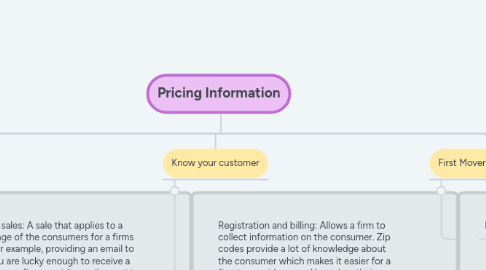
1. Marketing
1.1. E-mail marketing: Promotional and retention based emails; Promotional emails are intended to appeal to the consumer and encourage them to buy a good. Retention emails are information based-- for example a newsletter or an email about updated store hours.
1.1.1. Direct marketing: A good way for new companies to expand their consumers by contacting consumers directly and providing some sort of coupon, sample, or information that the consumer would most likely be interested in.
2. Promotion
2.1. Offering sales: A sale that applies to a percentage of the consumers for a firms good. For example, providing an email to see if you are lucky enough to receive a discount, or a firm providing a discount to every 20th person that visits the site.
2.1.1. Measure demand: Used to estimate price sensitive to further enhance profits.
3. Know your customer
3.1. Registration and billing: Allows a firm to collect information on the consumer. Zip codes provide a lot of knowledge about the consumer which makes it easier for a firm to provide a good based on their demographic.
3.1.1. Observation: Observe the consumers online behavior leads to knowing what the customer is looking for and seeing if they find it or not. This enhances a firm's idea of how to personalize an aspect of their good to appeal to a number of consumers.
4. First Mover Advantages
4.1. Early Presence in the market
4.1.1. Don't be greedy: Keep the good priced fairly and be willing to sacrifice short term margins.
4.1.1.1. Play tough: find a way to have a credible signal sent that the entry in the market will be matched with aggressive pricing.
5. Costs
5.1. First Copy Cost: The cost of producing the first unit of an item. This is the most pricey step in production. For example, writing a book or a script.
5.1.1. Sunk Costs: A cost that is unrecoverable if the production of a good is halted. For example, making a video game that is not profitable or that doesn't succeed.
5.1.2. Variable Costs: The reproduction cost, which is close to zero, of an additional unit or good. For example, making CDs of a movie.
6. Market Structure
6.1. Dominant firm: This model doesn't always represent the company that produces the best product per se, but the quality and economy of scale provides a cost advantage over other producers.
6.1.1. Differential product: A market where numerous firms produce a similar good, but with with different unique qualities to each.
7. Price Sensitivity
7.1. Members of different groups that differ in their customer value. This is seen all over the market for information goods to appeal to the groups who value these goods differently.
7.1.1. EX: Students, senior citizens

